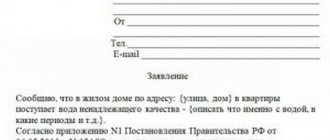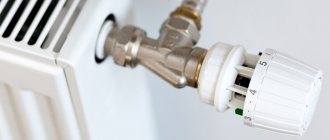In modern, comfortable houses, residents are provided with all utilities: heating, gas, electricity and, of course, water, both cold and hot. Uninterrupted payment of bills should guarantee the delivery of services in full. Often the service is not of sufficient quality, for example, the batteries are a little warm. This causes quite natural dissatisfaction among consumers. Most of the complaints relate to the non-compliance of the DHW temperature with SanPiN standards. In this article we will look at what to do if the hot water does not meet the standard and how to write a complaint.
Dear readers! Our articles talk about typical ways to resolve legal issues, but each case is unique. If you want to find out how to solve your specific problem, please contact the online consultant form on the right. It's fast and free! Or call us at 8(800)-350-30-02 (the call is free for all regions of Russia)!
Current legislature
Legal standards set out very clearly the requirements for hot water supply in multi-apartment residential buildings. They are set out in two main regulations.
This:
- approved by Decree of the Government of the Russian Federation No. 354 of 05/06/11 “Rules for the provision of utility services to owners and users of premises in apartment buildings and residential buildings.” Appendix No. 1 – “Requirements for the quality of public services”;
- Sanitary and epidemiological rules and norms approved by the Resolution of the Chief State Sanitary Doctor. Abbreviated as SanPiN 2.1.4.2496-09 “Hygienic requirements for ensuring the safety of hot water supply systems.”
Important! According to these regulations, hot water supplied to housing must meet the following requirements:
- be no lower than + 60 and no higher than + 75 degrees, regardless of the heating system installed in the residential building;
- To measure the temperature of the supplied water, you must leave the tap open for three minutes and only then take measurements.
Depending on the time of day, the following permissible temperature deviations are possible:
- from 0.00 a.m. to 5.00 a.m. - no more than 5 degrees in one direction or another;
- from 5.00 am to 00.00 am - such a deviation is permissible by no more than 3 degrees.
If water is supplied at the appropriate temperature, then consumers pay its cost at the full rate.
If the water temperature does not meet the stated requirements, then you should pay based on the following:
- at temperatures below 40 degrees, payment is made as for cold water. However, for this it is necessary to record this fact. Draws up a corresponding act with a call from a representative of the heat supply organization;
- for water supply whose temperature is above 40 degrees, but below 60, the payment tariff is reduced by 0.1 percent for each hour of water supply at this temperature. Again, this fact must be recorded with the drawing up of an act.
What standards are set?
Sanitary regulations oblige to ensure biological and chemical safety, cleanliness and transparency of hot water.
Requirements of sanitary and epidemiological laws for the quality of supplied water
Hot water supplied to residential buildings must meet the criteria of sanitary rules and regulations to ensure its safety:
- do not contain pathogens of dangerous infections;
- include a specified minimum of chlorine compounds;
- exclude skin diseases due to poor quality composition.
The temperature of hot water in the places where it is used should not depend on the design of the water supply system. Hygienic requirements do not allow the use of process water.
In centralized hot water supply systems, it is allowed to use only products that have passed the sanitary and epidemiological examination of institutions accredited for such types of work.
For what reasons can hot water be lukewarm?
The supply of hot water to multi-storey residential buildings, which does not correspond to the established temperature regime, can occur for various reasons.
Please note! The first is the fault of the heating supply organization, which does not heat the water to the established temperature conditions.
The second is the design flaws in the installation of the hot water supply system. As a result, there is no sufficient circulation of hot water, and residents have to drain the water that has cooled overnight until hot water flows.
Thirdly, perhaps the reason is in the pipe itself through which hot water flows. For example, she hid herself on the floor below. Everyone who lives below has hot water, and those on the upper floors have warm water. To rectify the situation, you must contact the management company, which is obliged to carry out the necessary inspection and eliminate the blockage of the pipe.
Fourthly, incorrectly installed devices in the path of water movement. The same principle as for clogging. Someone reinstalled the faucet and boiler and cut off sufficient water flow through the riser. As a result, everything is fine with him, but his neighbors suffer.
Fifthly, the residential building was the last one on the hot water supply line. That is, in a dead-end zone. It is further aggravated by the fact that the hot pipeline is not looped, but simply ends in the house. Then the problem of hot water will be constant.
Since the previous houses will take away all the hot water, and it will reach the dead-end volume already cooled. That is, not heated to the required temperature.
The only way out of this situation is to loop back the hot water supply line. This is almost impossible, as it costs a lot of money. These are design costs. There can only be one way out - installing an electric boiler and refusing hot water supply.
Also, one of the reasons for the lack of hot water supply may be an accident in the supply system outside the house. In this case, all you have to do is wait until the breakdown is fixed.
Actions when a temperature discrepancy is detected
You can detect a decrease in parameters by first measuring the water temperature yourself. If the temperature parameter decreases, you can request a recalculation for hot water of inadequate quality.
Such measurements are not evidence for recalculating fees for hot water supply. But they are necessary to initiate the creation of a commission with representatives of the management company. First of all, you need to find out information about the accident in the networks, since in an emergency, measurements of water parameters are not carried out. In the absence of an accident, an application for poor-quality provision of services is accepted by an official of the enterprise. It is better in writing with a note on the consumer’s copy indicating receipt.
The service organization sends its employee to measure the parameters with a thermometer certified in state metrology. The reliability of measurement data is achieved by repeatedly collecting water and preferably in different apartments. The measurement data is recorded in a report in which the residents also sign.
It is important to know that utility companies are interested in the quality performance of their duties, since their activities are monitored and, if performed improperly, a controversial issue can result in a serious fine. If the temperature does not match, residents are entitled to a recalculation for hot water.
How to measure water temperature yourself
Before calling representatives of the heat supply organization, housing office, or management company regarding the temperature of the hot water, you should make sure for yourself what indicators the water has.
Attention! To do this, you need to do the following manipulations:
- fully open the hot water supply tap and drain it within three to five minutes;
- fill a container with tap water;
- Using a household thermometer, measure how hot the water is. To do this, immerse the device in liquid for several minutes.
Based on the results of independent measurements, make a decision whether or not to call representatives of the relevant services to draw up a report.
Attention! Our qualified lawyers will assist you free of charge and around the clock on any issues. Find out more here.
Voting: which mechanical water meter is the best?
Which mechanical water meters would you choose or recommend?
ITELMA WFW20 D080
0.00 % ( 0 )
Meter SVU-15
0.00 % ( 0 )
Decast Metronic VSKM 90-15 DG
0.00 % ( 0 )
Zenner ETWI-N DN 15
0.00 % ( 0 )
ITELMA WFW24 D080
0.00 % ( 0 )
Valtec 1/2
100.00 % ( 1 )
Standard SVK-25
0.00 % ( 0 )
Gardena Water Smart
0.00 % ( 0 )
What to do if the hot water is not up to standard
Having established by independently measuring the temperature that the water supplied to the apartment does not meet the standards, it is necessary to take steps in accordance with Government Decree No. 354, which establishes the rules for the provision of utility services.
The consumer's action algorithm should be as follows:
- call or send a written message to the dispatch service of the heating supply organization that the temperature of the supplied water does not meet the standards. All types of citizen appeals, regardless of their form, are registered. In this case, the consumer is obliged to indicate his last name, first name, patronymic, address of residence, day and time of measuring the hot water temperature;
- if the appeal was oral, then the dispatcher is obliged to inform who exactly received the citizen’s message, and under what number it is registered in the book. If a written document was submitted, then on the second copy the dispatcher puts a mark on the date of acceptance of the request and the number in the incoming correspondence book;
- if there are any problems with the hot water supply due to the fault of the company, the applicant must be notified about this, and the cause of the breakdown and the estimated time of elimination must be given;
- if the reason for the supply of hot water with a low temperature regime to the heating supply organization is not known, the time for representatives to travel to take measurements and draw up a report must be agreed upon. Paragraph 108 of Resolution No. 354 sets a deadline for this - no later than two hours after the message, the check must be carried out. However, the parties may agree on a different time;
- After representatives of the heat supply organization visit the applicant’s place of residence, appropriate measurements are taken and a report is drawn up. This document confirms or refutes the facts stated in the consumer’s application. It may happen that the temperature will improve before the representatives arrive;
- the inspection report is drawn up in several copies. One for the consumer and thermal workers, and one copy for other departments if they took part in the departure based on a citizen’s report.
ATTENTION! Look at the completed sample complaint to the management company regarding the non-compliance of hot water with standards:
How to properly file a claim
There is no single standard for filing a claim for the supply of hot water with a temperature below the established standards. When drawing up a complaint, they are guided by generally accepted standards for writing statements.
The header of the appeal indicates the full name of the addressee, last name, first name, patronymic of the applicant, place of residence, status in relation to the occupied premises (owner, tenant), telephone number.
Request for recalculation or change in service tariffs
The text of the statement succinctly sets out the essence of the claims being made with reference to the relevant legislative norms. If the complaint concerns the low temperature coming from a hot water tap, they write exactly about this, indicating any deviations from standard indicators.
In the final part of the claim, they are asked to organize an authoritative commission to conduct an on-site inspection of the stated facts, draw up a report, eliminate existing violations, and recalculate utility bills for the required period.
Sample claim requesting recalculation of payments for hot water supply
How to request a recalculation
After the consumer has received a report confirming violations in the hot water supply, he applies for a recalculation. He submits such a document to the management company if it collects payments or to the heat supply organization if the payment goes directly to them.
Remember! The period for which recalculation must be made is determined from the date of documentary confirmation of the fact of the violation and ends on the day when such violation was eliminated.
Paragraph 112 of Government Resolution No. 354 determines the day for eliminating the identified violation as follows:
- the date when the consumer reported to the dispatch service that there were no more problems with the hot water supply;
- the date of the final inspection, based on the results of which a report was drawn up with the signature of the consumer stating that hot water is supplied at the required temperature.
Until the consumer reports that the problem has been corrected, or a re-inspection is performed and a report is drawn up, the period for providing low-quality service cannot be completed. Therefore, the consumer has the right to demand further recalculation.
The management company, housing office or heat supply organization do not have the right to refuse the consumer to measure the temperature of the supplied water. Moreover, they do not have the right to refuse recalculation if cold water was supplied instead of hot water.
If they do this, the consumer has the right to file a complaint with the prosecutor's office, the housing inspectorate, or file a lawsuit in court.
Proposed changes in standards for the provision of hot water supply services
Recently, Rospotrebnadzor has been actively discussing the issue of reducing the temperature standard for hot water supply from 60 to 50 degrees.
In this case, two options are proposed to solve the problem in order to save energy:
- The first option is to use special disinfectants for high-quality water purification, instead of heating. At the same time, experts assure that consumers will not become infected, since this is a more effective way to improve the quality of water supplied to apartments.
- The second option under consideration is lowering the water temperature to 50 degrees constantly and heating it to +70 degrees only once a day. According to experts, when offering such a measure of thermal disinfection, it is more effective, and this is proven by world experience, since many countries around the world use exactly this option for purifying water from bacteria living in it. To avoid accidental thermal injuries among consumers, heating to high temperatures is proposed to be done at night.
There are, of course, ardent opponents of such changes, who operate on the following quite fair considerations:
- Firstly, they believe, it is still necessary to take into account the opinion of the consumers themselves on this issue, since the changes will primarily affect their comfort and the amount of payment for the services provided (it seems that although the lower limit of heating will be lowered, the cost of the service will not be reduced will follow).
- Secondly, given, unfortunately, the current approach in the Russian public utilities sector to various changes, it is necessary to be prepared to obtain output parameters that will be below the established standards, since even today they are not always met. For example, if we are talking about reducing the heating level of hot water to 50 degrees, then in practice it is quite possible to get no more than 40÷45 degrees at the output, which is already “out of the question.” And discounts for such temperatures, taking into account the permissible 3 degrees of deviation, will turn out to be completely ridiculous. In short, the consumer is again the loser.
- Thirdly, the practice of functioning of the Russian housing and communal services does not allow us to be sure that in all municipalities without exception, high-quality purification of cold water will be carried out before heating it. Well, this may well lead to an increase in the likelihood of various infectious diseases. Therefore, opponents of the initiatives under discussion believe that in the conditions of the Russian communal system, only thermal treatment of water supplied to apartments is a truly effective method of disinfection in modern realities.
As of today, the previously developed standards are still in effect, while new ones were planned to be introduced in March 2021, but so far there is no official confirmation or refutation in this matter. It is known, however, that such an idea has not yet received approval from the Government of the Russian Federation. But who knows, maybe this will happen someday if alternative proposals that have long been adapted in our public utilities are not heard.
Video - What should be the temperature of hot water in the tap
Where can I complain?
The supply of hot water that does not meet established standards can be caused by both actions and inaction on the part of the management company, housing office, or heat supply organization.
As practice shows, service consumers prefer to first report the problem and insist on its elimination.
When a positive result is not achieved, the residents of the house begin to write complaints.
The initial authority they choose is the head of the heat supply organization, and then they involve such bodies as:
- state administration or local government;
- district prosecutor's office;
- state housing inspection;
- territorial division of Rospotrebnadzor.
As a last resort, a claim is filed with the court at the place of residence.
ATTENTION! Look at the completed sample complaint to the Prosecutor's Office against the Criminal Code regarding low hot water temperature:
Watch the video. The hot water temperature does not meet the standards:
Time limits for consideration of a complaint
The supplier is given a certain period of time to consider the complaint filed by the consumer. It may be specified in an agreement concluded between the parties or indicated in a consumer complaint.
If such a period is not provided for in the contract and is not specified in the complaint, then a 30-day period for response is usually accepted.
Instead of a complaint, the consumer can file a claim of similar content with a requirement to change the terms of the contract or terminate it.
In this case, two weeks are allotted for consideration of the claim. If the document was sent by mail, the time required for postal document circulation should be taken into account.
Application to the State Property Committee
An effective way to resolve the issue of hot water supply would be a complaint addressed to the state housing inspectorate. At the same time, what is stated in the document must be supported by references to the requirements of SNiP and SanPin, measurement reports drawn up by specialists or invited experts.
The redneck should be concise and as informative as possible. Do not contain insults or obscene statements.
Please note! As required details, the document must contain:
- surname and initials of the head of the state housing inspection;
- address of the location of the institution;
- last name, first name, patronymic and address of residence of the consumer of hot water supply services;
- if the complaint is collective, then the details of all residents who initiated and signed the document are indicated;
- title of the document “Complaint” or “Collective Complaint”;
- the essence of the violation, when, by whom it was recorded, what standards were violated;
- what measures were taken to resolve the conflict peacefully;
- reaction of the heat supply organization;
- legal grounds for filing a complaint with the housing inspectorate;
- requirements;
- copies of the attached documents;
- date, signature and transcript of the names of those who applied.
What t should be according to SNiP?
The minimum and maximum temperatures in water supply systems are recorded in SNiP 2.04.01-85.
In clause 2.2. This SNiP states that in open-type central hot water supply systems, the minimum temperature of the supplied water must be at least 60C. In closed systems, its minimum temperature indicator can be no less than 50C.
SNiP also sets the maximum value of t in water systems . It is the same for both open and closed central systems. Its value should not exceed 75C.
In preschool institutions, the maximum temperature for hot water supplied to washbasins and showers cannot be more than 37C. This is stated in clause 2.3. SNiP 2.04.01-85.
Claim to a judicial authority
If the legislation does not impose any requirements regarding the content of the document for drawing up a complaint and claim, then the statement of claim must comply with Article 131 of the Civil Procedure Code of the Russian Federation.
Otherwise, the court has every reason to refuse to accept the claim or leave it without consideration.
Therefore, the statement of claim must contain the following information:
- the name of the court where the claim is filed;
- name of the locality, name of the street, number of the building where the court is located;
- last name, first name, patronymic of the plaintiff, his place of residence, means of communication with him in the form of a landline or mobile phone number, email address;
- the full name of the defendant, its organizational and legal type of ownership, legal address, contact details, if known;
- price of claims;
- title of the document “Statement of Claim”;
- when and on what terms the contract for hot water supply was concluded between the parties;
- what obligations did the parties undertake;
- liability provided for by contract or law for violation of assumed obligations;
- when and under what circumstances a violation of obligations on the part of the defendant was recorded, what it consisted of and what evidence was confirmed;
- compliance with pre-trial dispute resolution procedures;
- legal grounds for seeking judicial protection;
- stated requirements;
- Attached documents;
- date, signature, surname and initials of the plaintiff.
Remember! The following can be used as an attachment to the statement of claim:
- a copy of the complaint or written message that the apartment is supplied with hot water that does not meet the stated requirements;
- act of measuring the temperature of the supplied hot water;
- a copy of the complaint and the response to it;
- other documents at the discretion of the plaintiff, for example, a copy of the power of attorney addressed to the representative, if the interests of the plaintiff are represented by this person.
The price of the claim will determine which court will consider the application. Thus, if the amount of the stated claims is up to 50 thousand, the case is under the jurisdiction of the magistrate, and if the stated claims exceed the specified figure - to the district court.
Filing a claim on the basis of the Federal Law on the Protection of Consumer Rights exempts the plaintiff from paying state fees. However, if, as a result of consideration of the claim, the defendant’s guilt is confirmed, the court will collect the appropriate amount of state duty from him.
Civil procedural legislation determines that claims of this category are filed with the court according to:
- place of legal registration of the defendant;
- place of conclusion of the contract.
If, when filing a statement of claim, the court comes to the conclusion that its content does not meet the requirements set out in Article 131 of the Code of Civil Procedure of the Russian Federation, or the rules of jurisdiction are not followed, the plaintiff will be given time to correct the errors. Otherwise, the claim will be considered not filed and will be returned to the initiator with all documents.
ATTENTION! View the completed sample statement of claim for recalculation of utility bills:
What to do if the sewage system in a high-rise building is clogged?
What to do if you bought an apartment with housing and communal services debts, read here.
How to submit a collective complaint to the Prosecutor's Office, read the link:
What is the importance of temperature standards for hot water supply?
Controlling the temperature of hot water supply is important, as mentioned above, not only for economic reasons, but also from the standpoint of preserving the health of residents, which is especially true for children and people with disabilities or chronic diseases. Therefore, water temperature indicators should not exceed the permissible threshold or be below normal.
Normal hot water temperature, within the established range, is not only a matter of comfort, but also ensuring the sanitary safety of residents
- The first thing to consider is that the temperature can often be not only low, but also exceed established standards, and this creates a considerable risk of burns. To eliminate the possibility of such damage, mixers are installed, with the help of which the desired water temperature is adjusted. Each user should remember what temperatures and how they can affect human skin:
— +50°C – partial burns are possible with exposure duration of 90 seconds or more;
— +55°C – the same situation, but the burn occurs in 15 seconds;
— +60°C – likely thermal damage to the skin when exposed for 5 seconds;
— +65°C – severe skin burn in 2 seconds;
— +70°C – immediate severe and deep burn of the skin and adjacent tissues.
Hot water standards
This information must be taken into account if there is a small child in the apartment - you should consider eliminating the possibility of his uncontrolled access to hot water taps.
Expert opinion: Masalsky A.V.
Editor of the “construction” category on the Stroyday.ru portal. Specialist in engineering systems and drainage.
A low temperature of the incoming “hot” water is not only its excessive consumption and other household inconveniences, but also a prerequisite for the emergence of a number of other unpleasant situations. In particular, in the closed space of pipes, when the temperature established by the standards decreases, a favorable environment is created for the appearance and reproduction of various bacteria that can cause temporary intoxication or even acute or chronic diseases in humans.
A typical representative of such pathogenic microflora is the Legionella bacterium, whose favorable habitat, development and reproduction is precisely warm fresh water. This microorganism is a gram-negative rod, no more than 3 microns in size.
Insufficient heating of water in the hot water supply system can lead to the rapid development of legionella colonies in pipes or boilers - a bacteria extremely dangerous to human health.
These microorganisms thrive in warm water and also readily settle in air conditioners and low-temperature heating systems. Legionella can cause various diseases, including lung infections and pneumonia with associated complications. This bacterium can enter the human body during a bath, shower, when washing or brushing teeth, as well as when eating food from dishes that were washed with insufficiently heated water.
Find out useful recommendations on which water filter to choose for your sink from a new article on our portal.
If the water meets the standards, then it is heated to higher temperatures, which minimizes the risk of infection to consumers. Thus, water heated to 80÷90 degrees in boiler houses of the central water supply practically undergoes a process of complete thermal disinfection.
The effect of temperature on the pathogenic microorganism discussed above looks approximately as follows:
— Water below +20˚С: the bacterium is inactive - it does not reproduce, but it does not die.
— +25÷45˚С: the most favorable temperature for the development and reproduction of legionella.
— +55˚С: if this temperature is continuously maintained, then these microorganisms die in 5–6 hours.
— +60˚С: the death of the entire colony of bacteria occurs within 30÷35 minutes.
— +65˚С — legionella dies within 2 minutes.
— +70÷80˚С: this range can already be considered the area of thermal disinfection of water.










